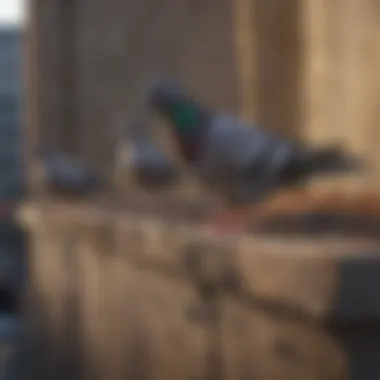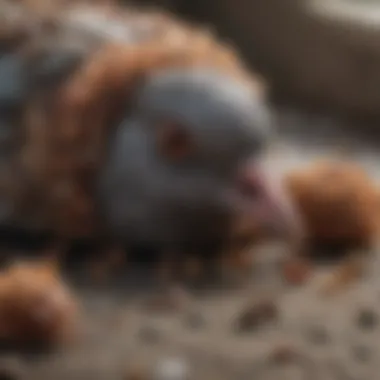Health Risks and Management of Pigeon Droppings


Intro
Pigeon excrement is often underestimated in terms of its potential risks. Many people overlook the health hazards associated with droppings from these birds. It is vital to recognize the connection between pigeon droppings and serious health implications. This article seeks to illuminate the dangers posed by pigeon excrement, the associated health risks, and the environmental impacts. Understanding these key aspects helps homeowners make informed decisions on how to manage and mitigate risks effectively.
Understanding Pests
Definition of Pests
Pests are organisms that can cause harm to property, plants, or humans. Pigeon excrement can be classified as a pest problem due to its adverse effects on public health and property condition. When pigeons roost in urban environments, their droppings accumulate and pose significant health threats.
Importance of Pest Identification
Identifying pigeons as a pest is the first step in effective management. Knowing their habits facilitates better control measures. Pigeons thrive in urban settings, often nesting on buildings, ledges, and other structures. Those living in areas with high pigeon populations should remain vigilant. Regularly inspecting the environment for droppings can help identify potential concerns quickly. This awareness not only protects individual health but also promotes community well-being.
Prevention Techniques
Home and Garden Preventative Measures
Preventing pigeon infestations involves several straightforward actions:
- Proper Waste Management: Secure trash bins to avoid attracting pigeons.
- Sealing Entry Points: Block gaps in structures where pigeons could nest.
- Use of Deterring Materials: Install spikes or nets on ledges.
These simple strategies reduce the likelihood of pigeons occupying a specific area.
Seasonal Prevention Tips
Pigeon behavior can vary with the seasons. During warmer months, they breed actively, making it essential to maintain vigilance. Here are key tips:
- In spring, regularly check for nesting activity.
- In winter, remove food sources, such as bird feeders in areas prone to pigeons.
By adapting strategies with seasonal changes, homeowners can effectively manage the risks related to pigeons.
Eco-Friendly Pest Control Solutions
Overview of Sustainable Practices
Sustainability is a growing concern among homeowners and pest control professionals alike. Effective management should prioritize eco-friendly practices. Integrating natural methods into pest control reduces harm to the environment while managing pigeon populations.
Natural Remedies and Their Effectiveness
Utilizing natural deterrents can yield significant results. Some options include:
- Essential Oils: Peppermint and citronella oil can repel pigeons.
- Scare Devices: Objects that move or reflect light may deter birds effectively.
These methods, while not guaranteed, can complement standard pest control strategies in keeping spaces safe from pigeon excrement.
Understanding the risks associated with pigeon droppings is imperative for maintaining health and safety.


As the discussion unfolds, it is important to synthesize the information presented, outlining effective measures, environmental considerations, and health implications, thus allowing homeowners to navigate the complexities surrounding pigeon management with greater confidence.
Prolusion to Pigeon Droppings
Pigeon droppings, though often dismissed, represent a significant concern that extends beyond mere inconvenience. They are one of the more noticeable signs of urban wildlife and can have profound implications for health and property maintenance. Understanding this topic is crucial for homeowners, city planners, and pest control agents alike. Assessing the risks associated with pigeon excrement enables informed decisions that protect both human health and structural integrity. This section lays the foundation for comprehending the behaviors of pigeons and the specifics of what their droppings contain.
Understanding Pigeon Behavior
Pigeons are commonly found in urban settings. Their behavior can vary depending on environmental factors and available resources. Typically, they are opportunistic feeders, often gravitating towards crowded areas where food is plentiful. This behavior contributes to their proliferation in cities, leading to increased interactions with human spaces. Pigeons tend to nest in areas that offer shelter from predators. Common nesting sites include ledges, rooftops, and under bridges. Understanding their habits helps in developing effective management strategies to mitigate risks associated with their presence.
The Composition of Pigeon Droppings
The droppings of pigeons consist of various components, reflecting their dietary habits. Primarily, pigeon feces contains uric acid, which is a byproduct of protein metabolism. This chemical compound appears as a white paste in their droppings and can be harmful. Droppings also carry seeds, plant matter, and other organic materials consumed by pigeons. Such a mixture can contribute to unsightly messes and attract unwanted pests. More crucially, pigeon feces can harbor pathogens that pose health risks to humans. Knowing the composition can better elucidate the potential hazards that homeowners must consider when dealing with pigeon infestations.
Health Risks Associated with Pigeon Droppings
Understanding the health risks associated with pigeon droppings is crucial due to the potential dangers they pose to human health and safety. These droppings can harbor a variety of pathogens that may lead to serious illnesses. Residents in urban and suburban areas often encounter the excrement of pigeons, particularly when these birds are congregated in large numbers. Recognizing the associated risks encourages effective management strategies to protect personal and community health.
Pathogens Found in Pigeon Poop
Pigeon droppings can contain numerous pathogens, which include bacteria, fungi, and viruses. Among these, one of the more concerning fungi is Cryptococcus neoformans. This particular microbe can thrive in environments rich with pigeon feces, posing a significant health threat, especially to individuals with compromised immune systems. Moreover, the presence of various bacteria may further complicate the risk landscape. People need to understand these pathogens as they play a central role in the spread of various diseases.
Transmission of Diseases
Histoplasmosis
Histoplasmosis is a respiratory disease caused by the fungus Histoplasma capsulatum, which can be found in pigeon droppings. It thrives in soil contaminated by these droppings, releasing spores into the environment. Inhalation of these spores can lead to infection, particularly affecting those with weakened immune systems. The key characteristic of histoplasmosis is its asymptomatic nature in some cases. This can be a disadvantage as many individuals may remain unaware of their infected status. Its inclusion in this article is essential for raising awareness about the need for proper prevention measures.
Candidiasis
Candidiasis is another health risk tied to pigeon droppings. This condition, caused by the overgrowth of fungi from the Candida species, can lead to various symptoms in humans, ranging from mild to severe. The simple fact that it can spread from pigeons to humans necessitates attention. An advantage of knowing about candidiasis is the early identification of symptoms, which can prevent serious health issues. Aware homeowners will find it beneficial to understand how these influences can arise from their environment, particularly pigeon-infested areas.
Cryptococcosis
Cryptococcosis is an infection caused by the fungus Cryptococcus neoformans, which can be directly linked to pigeon droppings. This pathogen is especially dangerous because it can cause meningitis in healthy individuals as well. The key feature of cryptococcosis is its potential for severe neurological complications, making it critical for discussions about pigeon-related health risks. Its inclusion in this article highlights the need to mitigate exposure to pigeon droppings to protect against life-threatening conditions.
Symptoms and Risks for Humans
Humans exposed to the pathogens present in pigeon droppings can experience a range of symptoms. These may include respiratory issues, fever, fatigue, and muscle aches. Furthermore, those with compromised immune systems are at an even greater risk for severe health issues, including pneumonia and systemic infections. Understanding these symptoms is crucial for early diagnosis and treatment, as neglect may lead to more severe conditions.
Environmental and Structural Effects
Corrosion and Damage to Buildings


Pigeon droppings contain uric acid, which can be corrosive, especially in high concentrations. This acid breaks down materials like wood, metal, and stone, leading to significant structural damage over time. For instance, when pigeon droppings accumulate on roofs, gutters, or ledges, they can create an environment conducive to decay. Components like roofing tiles may lose structural integrity as they corrode, leading to leaks and expensive repairs.
Homeowners should also be aware that the presence of pigeon droppings can decrease a property's value. Potential buyers often perceive the need for extensive cleaning and repair as a red flag. Not only does this create an immediate financial burden, but it can affect future resale opportunities.
As part of preventive measures, regular cleaning of areas prone to pigeon deposits is critical. Ideally, homeowners implement protective solutions, like pigeon spikes or netting, to minimize droppings' impact on vulnerable structures.
Impact on Local Ecosystems
Pigeon excrement has a notable impact on local ecosystems. While it may seem trivial, the accumulation of this waste can alter local soil quality and affect the plants that grow in the area. The nutrients found in pigeon droppings can encourage the growth of certain plants, disrupting the ecosystem's natural balance.
Moreover, these changes can affect wildlife. Some species may thrive in this altered environment, leading to an imbalance that could harm native flora and fauna. The urban environments where pigeons often inhabit can become particularly susceptible to such shifts. This can eventually affect local biodiversity, putting stress on species that are essential for a healthy ecosystem.
In summary, the effects of pigeon excrement on the environment and structures require attention. Homeowners must stay informed about the risks to maintain their property and contribute positively to their local ecosystem. Measures like habitat alterations and regular maintenance can mitigate these impacts, emphasizing the need for responsible stewardship of both concrete and green spaces.
Preventive Measures Against Pigeon Infestation
Taking effective preventive measures against pigeon infestation is crucial for maintaining healthy living spaces and protecting property. Pigeons can cause various problems, from health risks associated with their droppings to structural damage caused over time. Investing time and resources into preventive strategies allows homeowners to avoid escalation of these issues. Identifying problem areas, utilizing exclusion techniques, and establishing sanitation protocols create a comprehensive defense against the unwanted presence of pigeons.
Identifying Problem Areas
The first step in preventing pigeon infestation is identifying problem areas around a property. Pigeons are attracted to locations that provide both food sources and shelter. Common problem areas include:
- Roofs and balconies: These spaces are often used for nesting.
- Window ledges and sills: They offer easy perching spots for pigeons.
- Outdoor dining areas: Food scraps can entice pigeons.
- Eaves and ventilation systems: These can provide shelter.
Homeowners should regularly inspect these areas for signs of pigeon activity. This may include droppings, feathers, or nesting materials. Understanding where pigeons congregate can help in developing targeted strategies for exclusion and sanitation.
Effective Exclusion Techniques
Implementing effective exclusion techniques can significantly reduce the likelihood of pigeon infestation. These techniques involve both physical barriers and environmental modifications. Consider the following approaches:
- Installing netting: Bird netting can physically block pigeons from accessing ledges and balconies. This should be secured tightly to avoid gaps.
- Using spikes: Installing anti-perch spikes on window sills, rooftops, and ledges discourages pigeons from resting.
- Applying bird gel: This non-toxic gel creates a sticky surface that makes perching uncomfortable for birds.
- Removing food sources: Ensure no food is left outside. Secure trash bins and cover compost piles.
Making these modifications will not only minimize the appeal of structures for pigeons, but will also enhance the overall aesthetics of your property.
Sanitation and Cleaning Protocols
Maintaining cleanliness is a vital component of pest prevention. Developing proper sanitation and cleaning protocols can deter pigeons from inhabiting an area. To create an effective routine, homeowners should:
- Regularly clean outdoor areas: Sweep and wash surfaces where food residue may accumulate. This includes patios, driveways, and walkways.
- Dispose of droppings promptly: Use appropriate protective gear when cleaning pigeon droppings. This minimizes health risks associated with pathogens.
- Treat nesting sites carefully: If nests are found, removal should be conducted humanely and in accordance with local regulations.
Establishing these hygiene practices not only reduces the risk of attracting pigeons but also fosters a healthier environment.


Maintaining diligence in assessing, excluding, and sanitizing is essential for an effective defense against pigeon infestation.
Through these preventive measures, homeowners can proactively protect their spaces from the impact of pigeons and their droppings.
Legal and Ethical Considerations
Understanding the legal and ethical considerations surrounding pigeon excrement is crucial. As we assess the risks associated with pigeon droppings, it is equally essential to explore how laws and ethical standards govern the management of these birds. Pigeon control measures must balance the needs of property owners with humane treatment of the birds. This section elucidates relevant local regulations and explores the broader ethical implications of bird deterrence practices.
Local Regulations on Bird Control
Different localities have unique regulations concerning bird control. These regulations can significantly affect how homeowners and pest control professionals manage pigeon populations. Laws often include guidelines on when and how to remove or control birds, respecting their rights as wildlife.
In some regions, local ordinances may prohibit the harming of pigeons or require permits for removal. Others may advocate for non-lethal deterrent methods, focusing on prevention rather than extermination. Homeowners need to familiarize themselves with local laws to avoid legal repercussions.
- Research Local Laws: Know your area's specific regulations regarding bird control. This may include contacting local wildlife management agencies or city ordinances.
- Consider Permits: In certain places, specific activities like trapping may require permits. Ensure compliance to avoid hefty fines.
- Non-Lethal Methods: Explore methods that comply with regulations, such as spikes, nets, or sound deterrents.
Understanding these regulations ensures that property owners approach pigeon control responsibly, adhering not only to legal guidelines but also promoting public safety.
Ethics of Bird Deterrence
Beyond legal guidelines, ethical considerations play a significant role in how we approach pigeon management. Pigeons, like all wildlife, deserve humane treatment, which makes the method of deterrence and control ethically important. The goal is to find methods that minimize harm and promote safe coexistence.
Homeowners often grapple with the dilemma of managing pests while upholding ethical standards, leading to several critical considerations:
- Humaneness of Methods: Evaluate whether the methods used to deter pigeons are humane and justifiable regarding animal welfare.
- Long-Term Solutions: Consider sustainable practices for bird control that do not rely excessively on harmful measures. Long-term solutions promote environmental health and ethical responsibility.
- Community Awareness: Engage the community in awareness and education about the importance of responsible bird control. Increasing public knowledge can lead to better practices and community support.
Pigeons are often seen as nuisances, but recognizing their role in the ecosystem fosters a more responsible approach to control.
Overall, navigating the legal and ethical landscape of pigeon control can contribute to a safer environment and encourage more mindful management of these birds.
The End
Understanding the risks associated with pigeon excrement, or droppings, is essential for maintaining both public health and property integrity. Pigeon poop is more than just an unsightly nuisance; it carries several health hazards, particularly through the pathogens that thrive within it. Moreover, the excrement can cause significant damage to buildings and infrastructure, leading to costly repairs and potential safety issues. Therefore, recognizing these dangers and implementing preventive measures is not just advisable but necessary for homeowners and property managers alike.
Summary of Key Findings
The analysis of pigeon droppings elucidated several key points:
- Pathogens and Diseases: Pigeon droppings can harbor harmful pathogens, including those causing histoplasmosis, cryptocooccosis, and candidiasis. These illnesses may pose serious health risks to humans, particularly to those with compromised immune systems.
- Structural Damage: The acidic nature of pigeon droppings can lead to corrosion of metals and damage to materials like wood and stone. Over time, this can result in significant structural integrity loss, generating costly repairs.
- Environmental Impact: Pigeon waste contributes to urban pollution and can negatively affect local ecosystems, disrupting the balance of native species and benefiting only a few.
- Preventative Measures and Legal Considerations: Effective management strategies include sanitation, exclusion techniques, and understanding local regulations on bird control. Balancing ethical considerations with the need for pest control is crucial in these efforts.
"Awareness and timely actions can mitigate the hazards posed by pigeon excrement, contributing to a healthier environment for all."
Future Research Directions
Further investigation into pigeon droppings could focus on several areas:
- New Pathogen Discoveries: Continuous research in urban environments may reveal unknown pathogens associated with pigeon excrement, further informing health guidelines.
- Long-Term Environmental Effects: Understanding the long-term impact of pigeon populations on urban ecosystems could enhance wildlife management and urban planning strategies.
- Innovative Control Solutions: Exploring new technologies and eco-friendly repellents could provide homeowners with more effective deterrents against pigeon infestations.
- Public Health Initiatives: Programs aimed at educating the public on the risks of pigeon droppings will enhance community engagement and promote better maintenence practices in public spaces.
By continuing to research these dimensions, we can develop more nuanced approaches to manage and mitigate the risks associated with pigeon excrement.



